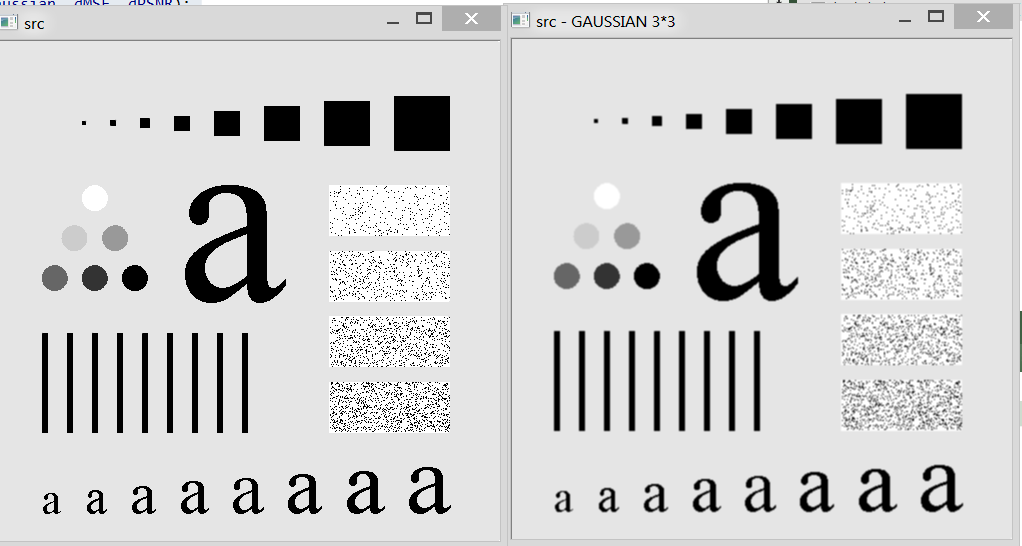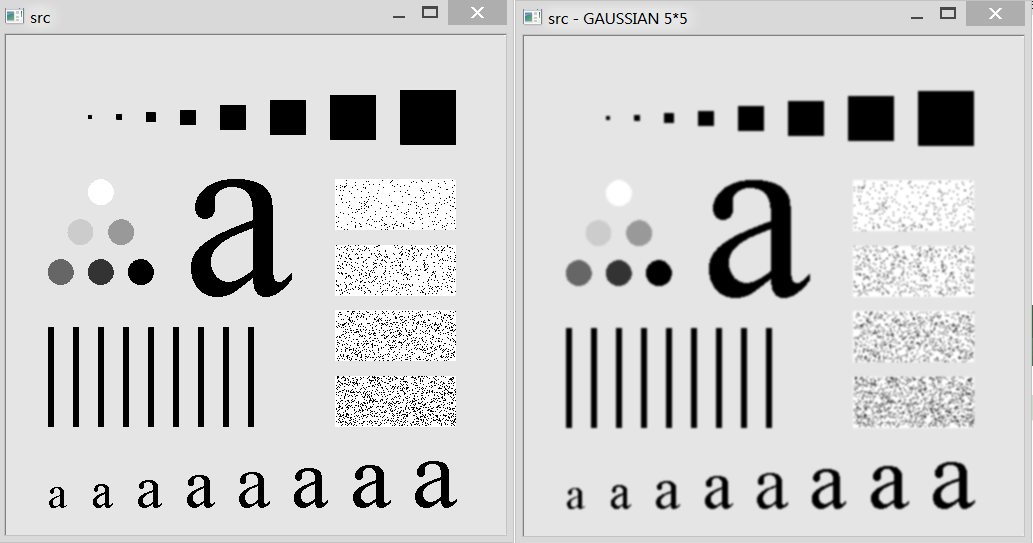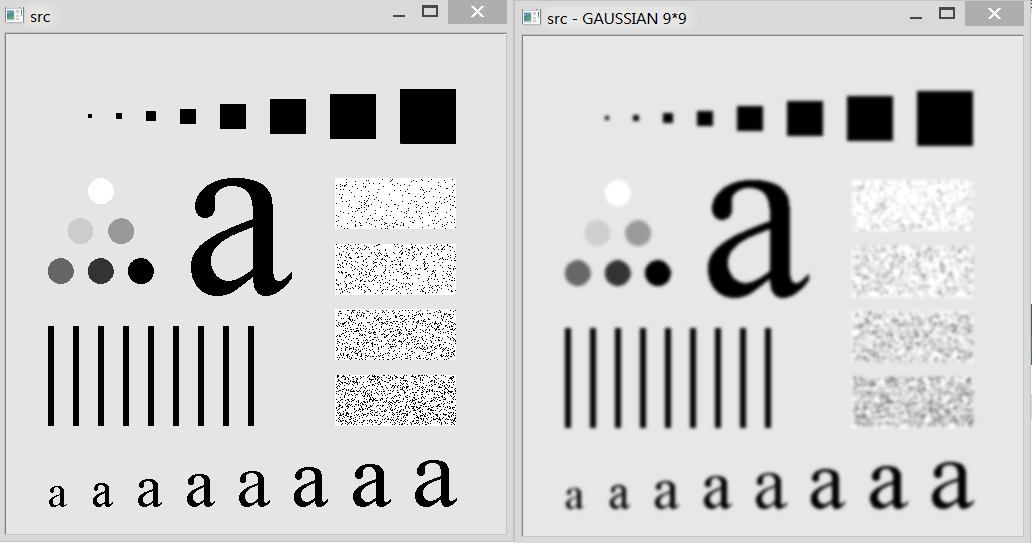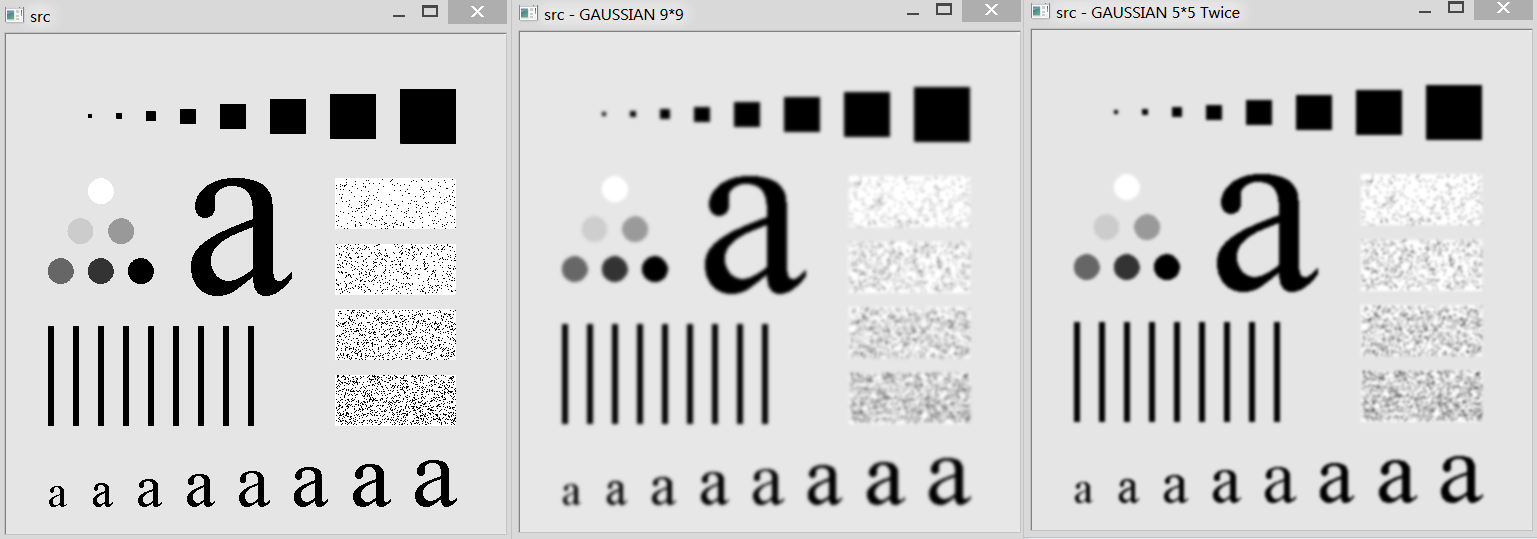《学习OpenCV》练习题第五章第一题ab
这道题是载入一幅带有有趣纹理的图像并用不同的模板(窗口,核)大小做高斯模糊(高斯平滑),然后比较用5*5大小的窗口平滑图像两次和用11*11大小的窗口平滑图像一次是否接近相同。
先说下我的做法,a部分我将每个不同的窗口大小模糊化后的图像生成后,还计算了每个模糊化后的图像与原始图像间的MSE值与PSNR值。(参见:http://zh.wikipedia.org/wiki/%E5%B3%B0%E5%80%BC%E4%BF%A1%E5%99%AA%E6%AF%94)
b部分我计算了两次5*5窗口大小的高斯模糊后的图像与一次11*11窗口大小的高斯模糊图像之间的MSE与PSNR。
代码:
#include <opencv/highgui.h>
#include <opencv/cv.h>
#include <opencv_libs.h>
#include <math.h> /*
*《学习OpenCV》第五章第一题
* 完成时间:18:37 10/13 星期日 2013
* 作者:qdsclove@163.com
*/ /*
* function: calculate MSE & PSNR of two GrayScale(8-bit depth & one channel) images.
* param: img1 -- the first image.
* param: img2 -- the second image.
* param: dMSE -- the MSE of two images(output)
* param: dPSNR -- the PSNR of two images(output)
* return: 0 -- success; others -- failed.
*/
int calculateGrayImgsPSNR(IplImage* img1, IplImage* img2, double& dMSE, double& dPSNR)
{
if( !img1 || !img2 ||
img1->nChannels != ||
img2->nChannels != ||
img1->depth != img2->depth ||
img1->width != img2->width ||
img1->height != img2->height )
{
return -;
}
int width = img1->width;
int height = img1->height; // calculate MSE of the two images
double dSumOfSquares = ;
for(int i = ; i < height; i++)
{
char* pdata1 = img1->imageData + i * img1->widthStep;
char* pdata2 = img2->imageData + i *img2->widthStep;
for(int j = ; j < width; j++ )
{
uchar value1 = *(pdata1 + j);
uchar value2 = *(pdata2 + j); double square = pow( (double)(value1 - value2), );
dSumOfSquares += square;
}
} dMSE = dSumOfSquares / (width * height); // this is means the two images are strictly same.
if(dMSE == )
{
dPSNR = -;
return ;
}
int iDepth = img1->depth;
int iMAX = pow( ., iDepth) - ; dPSNR = * log10(iMAX / (sqrt(dMSE))); return ;
} int main()
{
const char * FILE_PATH = "Fig0333(a)(test_pattern_blurring_orig).tif"; IplImage* src = cvLoadImage(FILE_PATH, CV_LOAD_IMAGE_UNCHANGED); if(!src)
{
printf("Load image error.\n");
return -;
} // Get the source image's size
CvSize srcSize = cvGetSize(src); // 3 * 3
IplImage* dst_three_gaussian = cvCreateImage(srcSize, src->depth, src->nChannels);
// 5 * 5
IplImage* dst_five_gaussian = cvCreateImage(srcSize, src->depth, src->nChannels);
// 9 * 9
IplImage* dst_nine_gaussian = cvCreateImage(srcSize, src->depth, src->nChannels);
// 11 * 11
IplImage* dst_eleven_gaussian = cvCreateImage(srcSize, src->depth, src->nChannels);
// twice 5 * 5
IplImage* dst_twice_five_gaussian = cvCreateImage( srcSize, src->depth, src->nChannels ); if( !dst_three_gaussian || !dst_five_gaussian ||
!dst_nine_gaussian || !dst_eleven_gaussian ||
!dst_twice_five_gaussian )
{
printf("Create image error.\n");
return -;
} cvSmooth(src, dst_three_gaussian, CV_GAUSSIAN, , );
cvSmooth(src, dst_five_gaussian, CV_GAUSSIAN, , );
cvSmooth(src, dst_nine_gaussian, CV_GAUSSIAN, , );
cvSmooth(src, dst_eleven_gaussian, CV_GAUSSIAN, , );
cvSmooth( dst_five_gaussian, dst_twice_five_gaussian, CV_GAUSSIAN, , ); cvShowImage("src", src);
cvShowImage("src - GAUSSIAN 3*3", dst_three_gaussian);
cvShowImage("src - GAUSSIAN 5*5", dst_five_gaussian);
cvShowImage("src - GAUSSIAN 9*9", dst_nine_gaussian);
cvShowImage("src - GAUSSIAN 11*11", dst_eleven_gaussian);
cvShowImage("src - GAUSSIAN 5*5 Twice", dst_twice_five_gaussian ); // calculate the MSE and PSNR of the two images.
double dMSE, dPSNR;
// part a:
calculateGrayImgsPSNR(src, dst_three_gaussian, dMSE, dPSNR);
printf("source image & 3*3 GAUSSIAN: MSE: %f\tPSNR: %f\n", dMSE, dPSNR);
calculateGrayImgsPSNR(src, dst_five_gaussian, dMSE, dPSNR);
printf("source image & 5*5 GAUSSIAN: MSE: %f\tPSNR: %f\n", dMSE, dPSNR);
calculateGrayImgsPSNR(src, dst_nine_gaussian, dMSE, dPSNR);
printf("source image & 9*9 GAUSSIAN: MSE: %f\tPSNR: %f\n", dMSE, dPSNR);
calculateGrayImgsPSNR(src, dst_eleven_gaussian, dMSE, dPSNR);
printf("source image & 11*11 GAUSSIAN: MSE: %f\tPSNR: %f\n", dMSE, dPSNR); // part b
puts("---------------------------\n");
calculateGrayImgsPSNR(src, dst_eleven_gaussian, dMSE, dPSNR);
printf("source image & eleven: MSE: %f\tPSNR: %f\n", dMSE, dPSNR);
calculateGrayImgsPSNR(src, dst_twice_five_gaussian, dMSE, dPSNR);
printf("source image & twice five: MSE: %f\tPSNR: %f\n", dMSE, dPSNR);
calculateGrayImgsPSNR(dst_eleven_gaussian, dst_twice_five_gaussian, dMSE, dPSNR);
printf("eleven & twice five: MSE: %f\tPSNR: %f\n", dMSE, dPSNR); cvWaitKey();
cvReleaseImage(&src);
cvReleaseImage(&dst_three_gaussian);
cvReleaseImage(&dst_five_gaussian);
cvReleaseImage(&dst_nine_gaussian);
cvReleaseImage(&dst_eleven_gaussian);
cvReleaseImage(&dst_twice_five_gaussian);
cvDestroyAllWindows(); return ;
}
运行结果:
a部分:
3*3:

5*5:

9*9:

11*11:

同时各个不同的窗口大小模糊化后的图像与原始图像之间的MSE与PSNR:

从图中可以看出,当窗口大小越大时,MSE增大,PSNR减小。
b部分:

两幅图像的PSNR与MSE:

众所周知的是在图像压缩中典型的PSNR比值在30-40dB之间,而我们这两幅平滑之后的图像PSNR为31.976534,所以这两幅图像是比较接近的。
《学习OpenCV》练习题第五章第一题ab的更多相关文章
- 《学习OpenCV》练习题第五章第二题abc
代码: #include <stdio.h> #include <opencv/highgui.h> #include <opencv/cv.h> #include ...
- 《学习OpenCV》练习题第四章第一题b&c
#include <highgui.h> #include <cv.h> #pragma comment (lib,"opencv_calib3d231d.lib&q ...
- 《学习OpenCV》练习题第四章第一题a
#include <highgui.h> #include <cv.h> #pragma comment (lib,"opencv_calib3d231d.lib&q ...
- 《学习Opencv》第五章 习题6
这是第五章 习题5.6的结合版,其中实现了摄像头抓拍功能,能够成功运行. #include "stdafx.h" #include "cv.h" #includ ...
- 《学习OpenCV》练习题第四章第二题
#include <highgui.h> #include <cv.h> #pragma comment (lib,"opencv_calib3d231d.lib&q ...
- 学习opencv中文版教程——第二章
学习opencv中文版教程——第二章 所有案例,跑起来~~~然而并没有都跑起来...我只把我能跑的都尽量跑了,毕竟看书还是很生硬,能运行能出结果,才比较好. 越着急,心越慌,越是着急,越要慢,越是陌生 ...
- Introduction to 3D Game Programming with DirectX 12 学习笔记之 --- 第五章:渲染流水线
原文:Introduction to 3D Game Programming with DirectX 12 学习笔记之 --- 第五章:渲染流水线 学习目标 了解几个用以表达真实场景的标志和2D图像 ...
- JavaScript DOM编程艺术-学习笔记(第五章、第六章)
第五章: 1.题外话:首先大声疾呼,"js无罪",有罪的是滥用js的那些人.js的father 布兰登-艾克,当初为了应付工作,10天就赶出了这个js,事后还说人家js是c语言和s ...
- C++ Primer Plus学习:第十五章
第十五章 友元.异常和其他 友元 友元类 表 0-1 class Tv { public: friend class Remote; } Remote类可以使用Tv的数据成员,Remote类在Tv类后 ...
随机推荐
- Volley HTTP库系列教程(2)Volley.newRequestQueue示例,发请求的流程,取消请求
Sending a Simple Request Previous Next This lesson teaches you to Add the INTERNET Permission Use n ...
- 《OD大数据实战》驴妈妈旅游网大型离线数据电商分析平台
一.环境搭建 1. <OD大数据实战>Hadoop伪分布式环境搭建 2. <OD大数据实战>Hive环境搭建 3. <OD大数据实战>Sqoop入门实例 4. &l ...
- 安装SQL2008的时候 出现System.Configuration.ConfigurationErrorsException: 创建 userSettings/Microsoft.SqlServe
System.Configuration.ConfigurationErrorsException: 创建 userSettings/Microsoft.SqlServer.Configuration ...
- LA 3983 Robotruck
这道题感觉挺吃力的,还用到了我不熟悉的优先队列 题目中的推导也都看明白了,总之以后还要多体会才是 这里用优先对列的原因就是因为要维护一个滑动区间的最小值,比如在区间里2在1的前面,2在离开这个滑动区间 ...
- 相对定位、绝对定位在IE6的问题
注意: 关于绝对定位,在IE6下定位元素的父级宽高都为奇数那么在IE6下定位元素的right,bottom都有一像素的偏差(left,top无偏差).因此应尽量使用偶数. 关于绝对定位,在IE6下父级 ...
- php实现一致性哈希算法
<?php//原理概念请看我的上一篇随笔(http://www.cnblogs.com/tujia/p/5416614.html)或直接百度 /** * 接口:hash(哈希插口).distri ...
- HDU 1512 Monkey King
左偏树.我是ziliuziliu,我是最强的 #include<iostream> #include<cstdio> #include<cstring> #incl ...
- scala学习笔记(8): 列表的map,flatMap,zip和reduce
map,flatMap,zip和reduce函数可以让我们更容易处理列表函数. 1 map函数map将一个函数应用于列表的每一个元素并且将其作为一个新的列表返回.我们可以这样对列表的元素进行平方: s ...
- JVM——新生代与老年代
首先看在JVM的堆中,按代的划分: Young:主要是用来存放新生的对象. Old:主要存放应用程序中生命周期长的内存对象. Permanent:是指内存的永久保存区域,主要存放Class和Meta的 ...
- 微软官方的一段JavaScript判断.net环境
<HTML> <HEAD> <TITLE>Test for the .NET Framework 3.5</TITLE> <META HTTP-E ...
